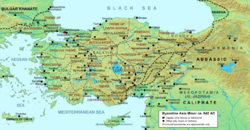Umar al-Aqta facts for kids
Quick facts for kids Umar al-Aqta |
|
|---|---|
| Emir of Malatya | |
| Reign | 830s–863 |
| Died | 3 September 863 Porson |
| Religion | Islam |
Umar al-Aqta was a powerful Arab leader, known as an emir, who ruled the city of Malatya from the 830s until his death in 863. His full name was Umar ibn Abdallah ibn Marwan, but he was often called "al-Aqta," which means "the one-handed" in Arabic. The Byzantines, who were his main rivals, called him Amer or Ambros.
Umar al-Aqta was a major threat to the Byzantine Empire on its eastern border. He led many attacks and became a famous figure in later Arabic and Turkish stories.
Contents
Umar al-Aqta's Story
Umar came from the Banu Sulaym tribe, a strong group living in the western Jazira region. This area was important because it was a border zone with the Byzantine Empire. Umar's father was also an emir of Malatya. Around 810, his father gave up a fortress to the Byzantines to free Umar, who was a prisoner.
Early Years and Big Battles
Umar likely became the emir of Malatya in the 830s. His first major appearance was in 838 during the Amorium campaign. This was a huge attack by the Caliph al-Mu'tasim against the Byzantines. It was in revenge for a Byzantine raid that had destroyed Malatya's lands.
Umar and his soldiers helped the Arabs win a big victory over the Byzantine Emperor Theophilos at the Battle of Dazimon in July 838.
Allies and Conflicts
In the 840s, Umar offered safety to a group called the Paulicians. They were being persecuted by the Byzantines. Umar gave them land around the fortresses of Tephrike, Amara, and Argaoun. Their leader, Karbeas, formed a separate Paulician state. This state became an ally of Umar, and together they often raided Byzantine lands.
In 844, Umar's forces took part in another big raid. They heavily defeated a Byzantine army led by their chief minister, Theoktistos, at the Battle of Mauropotamos. In the late 840s, Umar also fought against a neighboring Armenian lord named Skleros. He eventually defeated Skleros after a long and difficult conflict.
Raids and Retaliation
In the 850s, Umar defeated a Byzantine army led by Emperor Michael III near Samosata. He also carried out several successful raids into Byzantine territory. One raid went deep into the themes (Byzantine districts) of Thrakesion and Opsikion. It even reached a large Byzantine army base called Malagina in Bithynia.
However, Umar could not stop a counter-attack in 856. A Byzantine general named Petronas raided Malatya and Tephrike. He went all the way to Amida, taking many prisoners before returning home.
Final Battle and Legacy
In 860, Umar and Karbeas launched a major raid into Anatolia. They reached the Black Sea port of Sinope and returned with over 12,000 captured animals. Three years later, Umar was part of a large Abbasid army that invaded Anatolia.
After separating from the main army, Umar defeated a Byzantine force under Emperor Michael III in Cappadocia. He then headed north to attack the port city of Amisos. On his way back, the Byzantines surrounded him. Umar was killed at the Battle of Lalakaon on September 3, 863. Only a small part of his army escaped, but they were later defeated and captured.
When news of Umar's death reached Iraq, it caused riots in cities like Baghdad and Samarra. People were angry at the government's perceived weakness.
Umar's death marked the end of Malatya as a major military threat to Byzantium. The city remained under Muslim control for another 70 years. Umar was followed by his son, Abu Abdallah, and then his grandson, Abu Hafs. Abu Hafs was eventually forced to surrender Malatya to the Byzantine general John Kourkouas in 934.
Umar al-Aqta in Stories
Like many heroes from the Arab-Byzantine Wars, Umar al-Aqta appears in both Arab and Byzantine legends.
Arab and Turkish Legends
In the Arab epic story "Tale of Delhemma and al-Battal" (Sīrat Ḏāt al-Himma wa-l-Baṭṭāl), Umar is an important character. However, he is sometimes shown as almost a villain. This is because the story favors his tribe's rivals, who are the main heroes. Stories about Umar also seem to have influenced the tales of Umar ibn al-Numan and his sons, which are part of the One Thousand and One Nights. Umar himself appears in later Turkish epic stories about the hero Battal Ghazi.
Byzantine Legends
In Byzantine literature, many experts believe Umar is the inspiration for the emir Ambron. Ambron is the grandfather of the main hero in the epic poem Digenes Akritas. Some scholars also think he might be the hero of the Song of Armouris. Another scholar, Hans-Georg Beck, doesn't think so. But he points out that the same tale mentions a "short-armed" Arab leader, which might be a folk story based on Umar.
Finally, a scholar from the 10th century, al-Mas'udi, wrote that Umar was among the "illustrious Muslims." Their pictures were displayed in Byzantine churches to honor their bravery.
Images for kids
| Unknown | Emir of Malatya 830s – 863 |
Succeeded by Abu Abdallah ibn Umar al-Aqta |



